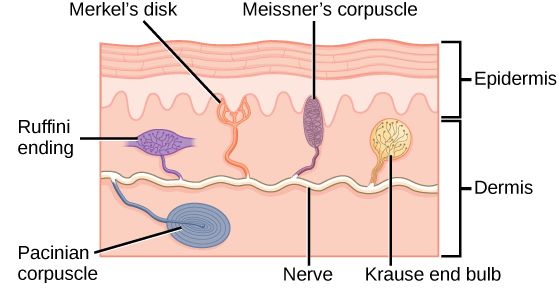
What are Ruffini corpuscles?
Answer
466.5k+ views
Hint: It is a receptor which is present on the skin. It is also known as bulbous receptors. These corpuscles play an important role in perception.
Complete answer:
The Ruffini corpuscle is named after Angelo Ruffini. It is located in the cutaneous tissues which lie in between the dermal papillae and the hypodermis. Ruffini corpuscles are spindle-shaped and are located inside the deep layers of the skin. These corpuscles are enlarged endings that have elongated capsules. They are present in high density around the fingernails. They are found in both hairy and glaborous skin. They are capable of recording low frequency and pressure.
Functions of Ruffini receptors-
- They are mechanoreceptors.
- These receptors are sensitive to the stretch of the skin.
- It controls the kinesthetic sense of finger movement. It controls the slippage and grip of objects.
- They show a response to sustained pressure.
- They also act as pain receptors.
- They also act as thermoreceptors.
Thus we can conclude that the Ruffini receptors are the mechanoreceptors present in our skin.

Additional information: The other two tactile receptors present on the skin are Meissner’s corpuscles and Pacinian corpuscles. The role of Meissner’s corpuscles is they sense pressure and lower frequency vibrations. The Pacinian corpuscles are able to sense transient pressure and high-frequency vibrations.
Note: The receptors present in our skin help in detecting the stimulus. The sensory receptors detect the stimulus and take it to the brain and spinal cord. The brain process the signals and the motor nerves carry the information from the brain to the muscles or target organs.
Complete answer:
The Ruffini corpuscle is named after Angelo Ruffini. It is located in the cutaneous tissues which lie in between the dermal papillae and the hypodermis. Ruffini corpuscles are spindle-shaped and are located inside the deep layers of the skin. These corpuscles are enlarged endings that have elongated capsules. They are present in high density around the fingernails. They are found in both hairy and glaborous skin. They are capable of recording low frequency and pressure.
Functions of Ruffini receptors-
- They are mechanoreceptors.
- These receptors are sensitive to the stretch of the skin.
- It controls the kinesthetic sense of finger movement. It controls the slippage and grip of objects.
- They show a response to sustained pressure.
- They also act as pain receptors.
- They also act as thermoreceptors.
Thus we can conclude that the Ruffini receptors are the mechanoreceptors present in our skin.

Additional information: The other two tactile receptors present on the skin are Meissner’s corpuscles and Pacinian corpuscles. The role of Meissner’s corpuscles is they sense pressure and lower frequency vibrations. The Pacinian corpuscles are able to sense transient pressure and high-frequency vibrations.
Note: The receptors present in our skin help in detecting the stimulus. The sensory receptors detect the stimulus and take it to the brain and spinal cord. The brain process the signals and the motor nerves carry the information from the brain to the muscles or target organs.
Recently Updated Pages
Master Class 11 Economics: Engaging Questions & Answers for Success

Master Class 11 English: Engaging Questions & Answers for Success

Master Class 11 Social Science: Engaging Questions & Answers for Success

Master Class 11 Biology: Engaging Questions & Answers for Success

Class 11 Question and Answer - Your Ultimate Solutions Guide

Master Class 11 Business Studies: Engaging Questions & Answers for Success

Trending doubts
10 examples of friction in our daily life

One Metric ton is equal to kg A 10000 B 1000 C 100 class 11 physics CBSE

Difference Between Prokaryotic Cells and Eukaryotic Cells

1 Quintal is equal to a 110 kg b 10 kg c 100kg d 1000 class 11 physics CBSE

Explain zero factorial class 11 maths CBSE

What is a periderm How does periderm formation take class 11 biology CBSE




